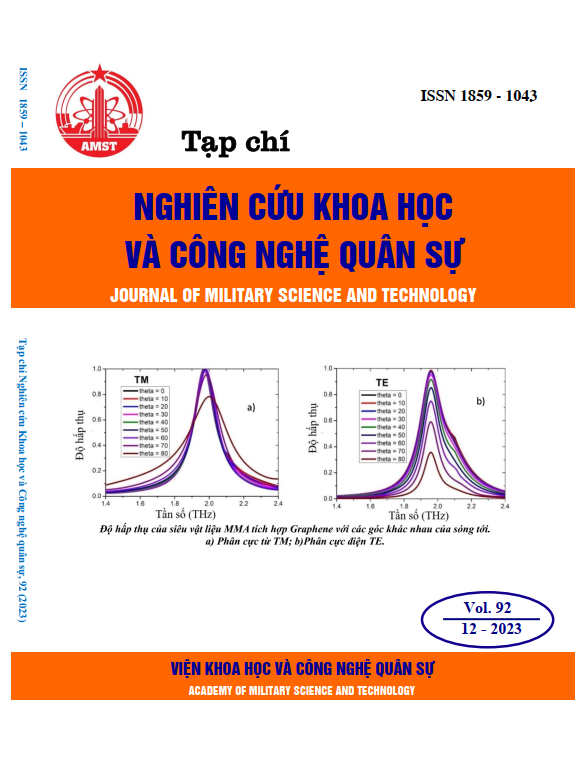Study to evaluate the effectiveness of deodorant product KMHS22 in training and camping conditions of soldiers
337 viewsDOI:
https://doi.org/10.54939/1859-1043.j.mst.92.2023.79-85Keywords:
KMHS22; Deodorant; NH3; H2S; Camping.Abstract
The study was conducted to evaluate the effectiveness of the deodorant product KMHS22 on the odorous gases H2S, NH3 in feces in training and camping conditions for soldiers in 2 seasoning temperature ranges (hot and cold seasons). The experiments were carried out in outdoor conditions (in the forest and in the bunker fortifications) with the temperature in the hot season (in May and June) and in the cold season (in November). The results showed that the KMHS22 preparation was effective in reducing the 2 odorous emissions in the sanitary waste. The average amounts of H2S, NH3 gases in the waste samples using 100 g of the preparation /sample remaining after 168 h were < 10 µg/m3 and < 100 µg/m3, which are below the allowable level for toxic gas according to QCVN 05: 2023/BTNMT. The removal efficiencies of H2S, NH3 gas of the preparation in the 2 seasoning conditions were in the range of 71% - 90% and 73,8%-91,6% respectively, compared to those of the control waste without using the preparation. KMHS22 product meets the purpose of controlling the amount of toxic and odorous gas in fortifications and underground tunnels for military training activities as well as ensuring environmental hygiene in outdoor conditions.
References
[1]. Burgess J. E., et al., "Developments in odour control and waste gas treatment biotechnology: a review." Biotechnology Advances, Vol 19, pp. 35-63, (2001). DOI: https://doi.org/10.1016/S0734-9750(00)00058-6
[2]. Sironi S., et al., "Odour impact assessment by means of dynamic olfactometry, dispersion modelling and social participation." Atmospheric Environment, Vol 44, pp. 354-360, (2010). DOI: https://doi.org/10.1016/j.atmosenv.2009.10.029
[3]. Mai X., et al. "Mùi hôi ảnh hưởng sức khỏe ra sao". (2018); Available from: https://tuoitre.vn/mui-hoi-anhhuong-suc-khoe-ra-sao.
[4]. Rose C., et al., "The Characterization of Feces and Urine: A Review of the Literature to Inform Advanced Treatment Technology." Crit Rev Environ Sci Technol, Vol 45, pp. 1827-1879, (2015). DOI: https://doi.org/10.1080/10643389.2014.1000761
[5]. Barbusinski K., et al., "Biological methods for odor treatment – A review." Journal of Cleaner Production, Vol 152, pp. 223-241, (2017). DOI: https://doi.org/10.1016/j.jclepro.2017.03.093
[6]. Estrada J., et al., "A Comparative Analysis of Odour Treatment Technologies in Wastewater Treatment Plants." Environmental science & technology, Vol 45, pp. 1100-6, (2011). DOI: https://doi.org/10.1021/es103478j
[7]. Ushida K., et al., "Isolation of Bacillus SP. as a Volatile Sulfur-Degrading Bacterium and Its Application to Reduce the Fecal Odor of Pig." Asian-Australas J Anim Sci, Vol 16, pp. 1795-1798, (2003). DOI: https://doi.org/10.5713/ajas.2003.1795
[8]. Yuan S., et al., "Application status and prospects of biological deodorization in China." IOP Conference Series: Earth and Environmental Science, Vol 631, pp. 012009, (2021). DOI: https://doi.org/10.1088/1755-1315/631/1/012009
[9]. Ye-Jin K., et al., "Evaluation of Bacillus amyloliquefaciens as manure additive for control of odorous gas emissions from pig slurry." African Journal of Microbiology Research, Vol 8, pp. 2540-2546, (2014). DOI: https://doi.org/10.5897/AJMR2014.6742
[10]. Nakada Y., et al., "Purification and properties of hydrogen sulfide oxidase from Bacillus sp. BN53-1." Journal of Bioscience and Bioengineering, Vol 87, pp. 452-455, (1999). DOI: https://doi.org/10.1016/S1389-1723(99)80093-0
[11]. Harindintwali J. D., et al., "Lignocellulosic crop residue composting by cellulolytic nitrogen-fixing bacteria: A novel tool for environmental sustainability." Science of The Total Environment, Vol 715, pp. 136912, (2020). DOI: https://doi.org/10.1016/j.scitotenv.2020.136912
[12]. Rastogi M., et al., "Microbes as vital additives for solid waste composting." Heliyon, Vol 6, pp. e03343, (2020). DOI: https://doi.org/10.1016/j.heliyon.2020.e03343
[13]. Sánchez Ó. J., et al., "Compost supplementation with nutrients and microorganisms in composting process." Waste Management, Vol 69, pp. 136-153, (2017). DOI: https://doi.org/10.1016/j.wasman.2017.08.012
[14]. Nowocień K., et al., "Bacillus spp. as a new direction in biocontrol and deodorization of organic fertilizers." AIMS Environmental Science, Vol 9, pp. 95-105, (2022). DOI: https://doi.org/10.3934/environsci.2022007
[15]. McCrory D., et al., "Additives to Reduce Ammonia and Odor Emissions From Livestock Wastes: A Review." Journal of environmental quality, Vol 30, pp. 345-55, (2001). DOI: https://doi.org/10.2134/jeq2001.302345x
[16]. Nam P. H., "Nhiệm vụ cấp Viện KHCNQS: Thiết kế thiết bị vệ sinh dã ngoại." Vol (2012).
[17]. Steiner C., et al., "Reducing Nitrogen Loss during Poultry Litter Composting Using Biochar." Journal of environmental quality, Vol 39, pp. 1236-42, (2010). DOI: https://doi.org/10.2134/jeq2009.0337
[18]. Turk A., et al., "Suprathreshold Odor Measurement by Dynamic Olfactometry: Principles and Practice." Journal of the Air Pollution Control Association, Vol 30, pp. 1289-1294, (1980). DOI: https://doi.org/10.1080/00022470.1980.10465183







